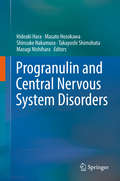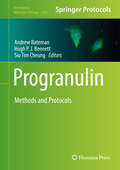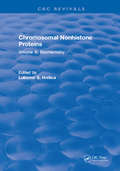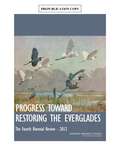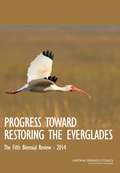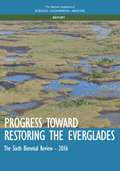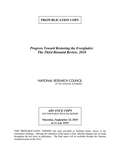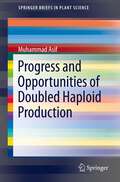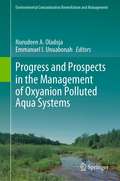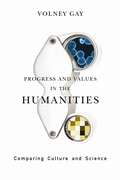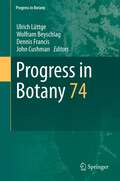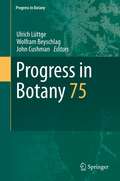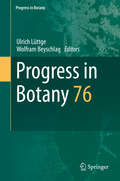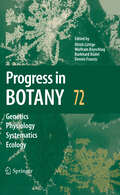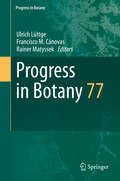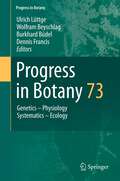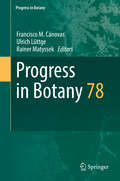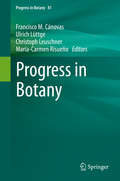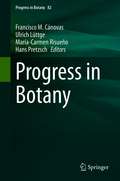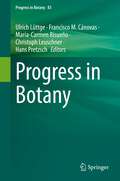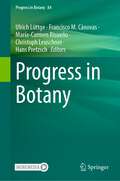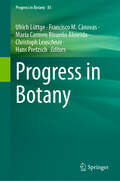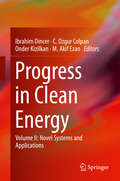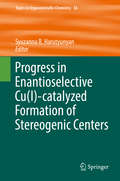- Table View
- List View
Progranulin and Central Nervous System Disorders
by Hideaki Hara Masato Hosokawa Shinsuke Nakamura Takayoshi Shimohata Masugi NishiharaThis book presents the latest knowledge on the roles of progranulin (PGRN) in normal physiology and pathology and explores the emerging significance of PGRN as a therapeutic target and biomarker in various CNS disorders, including frontotemporal lobe degeneration and other neurodegenerative diseases. Following initial recognition of the importance of PGRN in sexual differentiation of the developing brain and adult neurogenesis, it was subsequently discovered that PGRN acts as a chaperone of lysosomal enzymes and plays a crucial role in maintaining cellular protein homeostasis. It has also been found that sex steroids modulate the expression of PGRN and its trophic effects in the developing CNS and that PGRN directly or indirectly influences neural stem and progenitor cells. Against this background, deeper understanding of the molecular and functional properties of PGRN would provide fresh impetus for the development of mechanism-based therapeutic approaches for multiple disorders. Medications targeting the recovery of lysosomal function appear to hold particular promise in patients with neurodegenerative diseases resulting from PGRN insufficiency. In examining multiple aspects of this fascinating field, the book will be of high value for researchers and graduate students.
Progranulin: Methods and Protocols (Methods in Molecular Biology #1806)
by Andrew Bateman Hugh P.J. Bennett Siu Tim CheungThis volume explores experimental strategies to study progranulin as a regulatory protein in biological and disease processes. The chapters in this book are divided into four parts: Part One is an introduction to the topic; Part Two looks at analytical and in vitro methods to study progranulin biology; Part Three discusses the role of progranulin in cancer; and Part Four describes the process of using animal models to study progranulin in health and disease. Written in the highly successful Methods in Molecular Biology series format, chapters include introductions to their respective topics, lists of the necessary materials and reagents, step-by-step, readily reproducible laboratory protocols, and tips on troubleshooting and avoiding known pitfalls.Cutting-edge and thorough, Progranulin: Methods and Protocols is a valuable resource for experienced researchers who want to expand their studies of this field, and newcomers who want to begin including progranulin into their work.
Progress In Nonhistone Protein Research: Volume III
by I. BekhorAs a follow-up to Volumes I and II in this series, in this volume the authors attempt to provide an update into the current research in NHCP with the hope that these articles may foster a more analytical elucidation of the role of these proteins in gene expression.
Progress Toward Restoring the Everglades
by National Research Council Water Science and Technology Board Division on Earth and Life Studies Board on Environmental Studies and Toxicology Committee on Independent Scientific Review of Everglades Restoration ProgressTwelve years into the Comprehensive Everglades Restoration Project, little progress has been made in restoring the core of the remaining Everglades ecosystem; instead, most project construction so far has occurred along its periphery. To reverse ongoing ecosystem declines, it will be necessary to expedite restoration projects that target the central Everglades, and to improve both the quality and quantity of the water in the ecosystem. The new Central Everglades Planning Project offers an innovative approach to this challenge, although additional analyses are needed at the interface of water quality and water quantity to maximize restoration benefits within existing legal constraints. Progress Toward Restoring the Everglades: The Fourth Biennial Review, 2012 explains the innovative approach to expedite restoration progress and additional rigorous analyses at the interface of water quality and quantity will be essential to maximize restoration benefits.
Progress Toward Restoring the Everglades: The Fifth Biennial Review, 2014
by Committee on Independent Scientific Review of Everglades Restoration ProgressThe Everglades ecosystem is vast, stretching more than 200 miles from Orlando to Florida Bay, and Everglades National Park is but a part located at the southern end. During the 19th and 20th centuries, the historical Everglades has been reduced to half of its original size, and what remains is not the pristine ecosystem many image it to be, but one that has been highly engineered and otherwise heavily influenced, and is intensely managed by humans. Rather than slowly flowing southward in a broad river of grass, water moves through a maze of canals, levees, pump stations, and hydraulic control structures, and a substantial fraction is diverted from the natural system to meet water supply and flood control needs. The water that remains is polluted by phosphorus and other contaminants originating from agriculture and other human activities. Many components of the natural system are highly degraded and continue to degrade. "Progress Toward Restoring the Everglades" is the fifth biennial review of progress made in meeting the goals of the Comprehensive Everglades Restoration Plan (CERP). This complex, multibillion-dollar project to protect and restore the remaining Everglades has a 30-40 year timeline. This report assesses progress made in the various separate project components and discusses specific scientific and engineering issues that may impact further progress. According to "Progress Toward Restoring the Everglades," a dedicated source of funding could provide ongoing long-term system-wide monitoring and assessment that is critical to meeting restoration objectives. The report makes recommendations for restoration activities, project management strategies, management of invasive nonnative species, and high-priority research needs.
Progress Toward Restoring the Everglades: The Sixth Biennial Review - 2016
by Engineering Medicine National Academies of SciencesThe Everglades ecosystem is vast, stretching more than 200 miles from Orlando to Florida Bay, and Everglades National Park is but a part located at the southern end. During the 19th and 20th centuries, the historical Everglades has been reduced to half of its original size, and what remains is not the pristine ecosystem many image it to be, but one that has been highly engineered and otherwise heavily influenced, and is intensely managed by humans. Rather than slowly flowing southward in a broad river of grass, water moves through a maze of canals, levees, pump stations, and hydraulic control structures, and a substantial fraction is diverted from the natural system to meet water supply and flood control needs. The water that remains is polluted by phosphorus and other contaminants originating from agriculture and other human activities. Many components of the natural system are highly degraded and continue to degrade. Progress Toward Restoring the Everglades is the sixth biennial review of progress made in meeting the goals of the Comprehensive Everglades Restoration Plan (CERP). This complex, multibillion-dollar project to protect and restore the remaining Everglades has a 30-40 year timeline. This report assesses progress made in the various separate project components and discusses specific scientific and engineering issues that may impact further progress. According to Progress Toward Restoring the Everglades, a dedicated source of funding could provide ongoing long-term system-wide monitoring and assessment that is critical to meeting restoration objectives. This report examines the implications of knowledge gained and changes in widely accepted scientific understanding regarding pre-drainage hydrology, climate change, and the feasibility of water storage since the CERP was developed.
Progress Toward Restoring the Everglades: The Third Biennial Review - 2010
by National Research Council of the National AcademiesAlthough the progress of environmental restoration projects in the Florida Everglades remains slow overall, there have been improvements in the pace of restoration and in the relationship between the federal and state partners over the last two years. However, the importance of several challenges related to water quantity and quality have become clear, highlighting the difficulty in achieving restoration goals for all ecosystem components in all portions of the Everglades. Progress Toward Restoring the Everglades explores these challenges. The book stresses that rigorous scientific analyses of the tradeoffs between water quality and quantity and between the hydrologic requirements of Everglades features and species are needed to inform future prioritization and funding decisions.
Progress and Opportunities of Doubled Haploid Production
by Muhammad AsifDeals with the historical perspectives and the current status of doubled haploid production along with its practical implications in basic and applied research. It highlights various haploid production methods with a comprehensive discussion on their pros and cons, bottlenecks, and embryogenic pathways. The review also describes in detail the results of molecular and genomic studies conducted to investigate the underlying principles of this spectacular technique that has changed the status of many species from recalcitrant to responsive over the last ninety years.
Progress and Prospects in the Management of Oxyanion Polluted Aqua Systems (Environmental Contamination Remediation and Management)
by Nurudeen A. Oladoja Emmanuel I. UnuabonahThis book is a compendium of research efforts and findings on the sources, occurrences, hydrochemistry, and several operating variables that influence the presence of oxyanions in aqua system. The content of this book has been designed to provide an insightful account of an array of innovative technologies for the management of the impacts of oxyanions in water, the progress and drawbacks of these technologies and those that have been effectively deployed to transform oxyanions in water to beneficial species. This book further x-rays global laws and economic policies targeted at effectively curtailing the presence of harmful oxyanions in water, challenges facing these policies, and future perspectives on how best to reduce the level of these harmful oxyanions in water to safe limit. The book is relevant to water professionals, policy makers, academics, and research students.
Progress and Values in the Humanities: Comparing Culture and Science
by Volney GayMoney and support tend to flow in the direction of economics, science, and other academic departments that demonstrate measurable "progress." The humanities, on the other hand, offer more abstract and uncertain outcomes. A humanist's objects of study are more obscure in certain ways than pathogens and cells. Consequently, it seems as if the humanities never truly progress. Is this a fair assessment?By comparing objects of science, such as the brain, the galaxy, the amoeba, and the quark, with objects of humanistic inquiry, such as the poem, the photograph, the belief, and the philosophical concept, Volney Gay reestablishes a fundamental distinction between science and the humanities. He frees the latter from its pursuit of material-based progress and restores its disciplines to a place of privilege and respect. Using the metaphor of magnification, Gay shows that, while we can investigate natural objects to the limits of imaging capacity, magnifying cultural objects dissolves them into noise. In other words, cultural objects can be studied only within their contexts and through the prism of metaphor and narrative. Gathering examples from literature, art, film, philosophy, religion, science, and psychoanalysis, Gay builds a new justification for the humanities. By revealing the unseen and making abstract ideas tangible, the arts create meaningful wholes, which itself is a form of progress.
Progress and Visions in Quantum Theory in View of Gravity: Bridging Foundations of Physics and Mathematics
by Felix Finster Johannes Kleiner Jürgen Tolksdorf Domenico GiuliniThis book focuses on a critical discussion of the status and prospects of current approaches in quantum mechanics and quantum field theory, in particular concerning gravity. It contains a carefully selected cross-section of lectures and discussions at the seventh conference “Progress and Visions in Quantum Theory in View of Gravity” which took place in fall 2018 at the Max Planck Institute for Mathematics in the Sciences in Leipzig.In contrast to usual proceeding volumes, instead of reporting on the most recent technical results, contributors were asked to discuss visions and new ideas in foundational physics, in particular concerning foundations of quantum field theory. A special focus has been put on the question of which physical principles of quantum (field) theory can be considered fundamental in view of gravity.The book is mainly addressed to mathematicians and physicists who are interested in fundamental questions of mathematical physics. It allows the reader to obtain a broad and up-to-date overview of a fascinating active research area.
Progress in Botany
by Dennis Francis Wolfram Beyschlag Ulrich Lüttge John CushmanWith one volume each year, this series keeps scientists and advanced students informed of the latest developments and results in all areas of the plant sciences. The present volume includes reviews on genetics, cell biology, physiology, comparative morphology, systematics, ecology, and vegetation science.
Progress in Botany
by Wolfram Beyschlag Ulrich Lüttge John CushmanWith one volume each year, this series keeps scientists and advanced students informed of the latest developments and results in all areas of the plant sciences. The present volume includes reviews on genetics, cell biology, physiology, ecology, and vegetation science.
Progress in Botany
by Wolfram Beyschlag Ulrich LüttgeWith one volume each year, this series keeps scientists and advanced students informed of the latest developments and results in all areas of the plant sciences. The present volume includes reviews on physiology, ecology and vegetation science.
Progress in Botany 72
by Dennis Francis Wolfram Beyschlag Ulrich Lüttge Burkhard BüdelWith one volume each year, this series keeps scientists and advanced students informed of the latest developments and results in all areas of the plant sciences.
Progress in Botany 77
by Ulrich Lüttge Francisco M. Cánovas Rainer MatyssekWith one volume each year, this series keeps scientists and advanced students informed of the latest developments and results in all areas of the plant sciences. The present volume includes reviews on plant genetics, physiology, ecology, and evolution.
Progress in Botany Vol. 73
by Dennis Francis Wolfram Beyschlag Ulrich Lüttge Burkhard BüdelWith one volume each year, this series keeps scientists and advanced students informed of the latest developments and results in all areas of the plant sciences. The present volume includes reviews on genetics, cell biology, physiology, comparative morphology, systematics, ecology, and vegetation science.
Progress in Botany Vol. 78
by Ulrich Lüttge Francisco M. Cánovas Rainer MatyssekWith one volume each year, this series keeps scientists and advanced students informed of the latest developments and results in all areas of the plant sciences. The present volume includes reviews on plant physiology, biochemistry, ecology, and ecosystems.
Progress in Botany Vol. 81 (Progress in Botany #81)
by Ulrich Lüttge Francisco M. Cánovas Christoph Leuschner María-Carmen RisueñoWith one volume each year, this series keeps scientists and advanced students informed of the latest developments and results in all areas of the plant sciences. The present volume includes reviews on plant physiology, biochemistry, genetics and genomics, forests, and ecosystems.
Progress in Botany Vol. 82 (Progress in Botany #82)
by Hans Pretzsch Ulrich Lüttge Francisco M. Cánovas María-Carmen RisueñoWith one volume each year, this series keeps scientists and advanced students informed of the latest developments and results in all areas of the plant sciences. This latest volume includes reviews on plant physiology, biochemistry, genetics and genomics, forests, and ecosystems.
Progress in Botany Vol. 83 (Progress in Botany #83)
by Hans Pretzsch Ulrich Lüttge Francisco M. Cánovas Christoph Leuschner María-Carmen RisueñoWith one volume each year, this series keeps scientists and advanced students informed of the latest developments and results in all areas of the plant sciences. This latest volume includes reviews on plant physiology, biochemistry, genetics and genomics, forests, and ecosystems.
Progress in Botany Vol. 84 (Progress in Botany #84)
by Hans Pretzsch Ulrich Lüttge Francisco M. Cánovas Christoph Leuschner María-Carmen RisueñoWith one volume each year, this series keeps scientists and advanced students informed of the latest developments and results in all areas of the plant sciences. This latest volume includes reviews on plant physiology, biochemistry, genetics and genomics, forests, and ecosystems.
Progress in Botany Vol. 85 (Progress in Botany #85)
by Hans Pretzsch Ulrich Lüttge Francisco M. Cánovas Christoph Leuschner María Carmen Risueño AlmeidaWith one volume each year, this series keeps scientists and advanced students informed of the latest developments and results in all areas of the plant sciences. This latest volume includes reviews on plant physiology, biochemistry, genetics and genomics, forests, and ecosystems.
Progress in Clean Energy, Volume 1
by Ibrahim Dincer C. Ozgur Colpan Onder Kizilkan M. Akif EzanThis expansive reference on clean energy technologies focuses on tools for system modelling and analysis, and their role in optimizing designs to achieve greater efficiency, minimize environmental impacts and support sustainable development. Key topics ranging from predicting impacts of on-grid energy storage to environmental impact assessments to advanced exergy analysis techniques are covered. The book includes findings both from experimental investigations and functional extant systems, ranging from microgrid to utility-scale implementations. Engineers, researchers and students will benefit from the broad reach and numerous engineering examples provided.
Progress in Enantioselective Cu(I)-catalyzed Formation of Stereogenic Centers
by Syuzanna R. HarutyunyanThe series Topics in Organometallic Chemistry presents critical overviews of research results in organometallic chemistry. As our understanding of organometallic structure, properties and mechanisms increases, new ways are opened for the design of organometallic compounds and reactions tailored to the needs of such diverse areas as organic synthesis, medical research, biology and materials science. Thus the scope of coverage includes a broad range of topics of pure and applied organometallic chemistry, where new breakthroughs are being achieved that are of significance to a larger scientific audience. The individual volumes of Topics in Organometallic Chemistry are thematic. Review articles are generally invited by the volume editors. All chapters from Topics in Organometallic Chemistry are published OnlineFirst with an individual DOI. In references, Topics in Organometallic Chemistry is abbreviated as Top Organomet Chem and cited as a journal.
